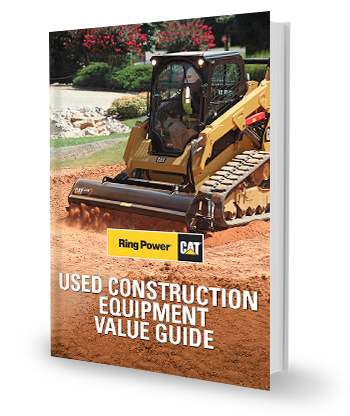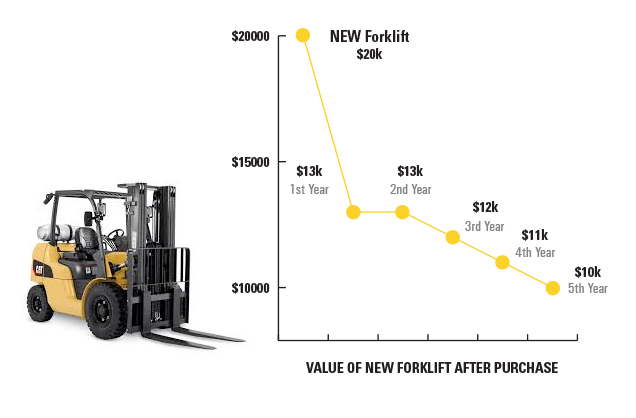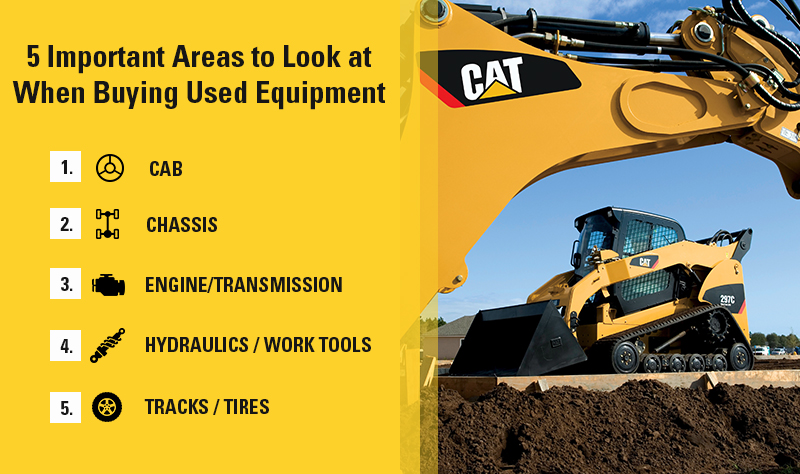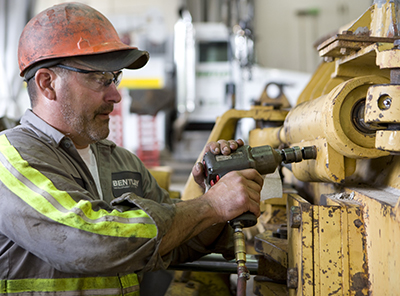
In today’s economy, controlling the spiraling costs associated with buying and maintaining equipment can be an important part of staying profitable.
Too often, equipment purchasing decisions are viewed as an unenviable dilemma: pay a premium for a new machine or deal with the long-term added service costs of buying used.
However, reductive thinking such as this can easily lead to paying too much when a less-expensive machine will do. Taking the time to research your purchase beforehand is essential. When it comes to used heavy equipment, knowing how to shop smartly will allow you to choose a machine that will deliver a lifetime of reliable performance at a fraction of the cost of buying new.
About Ring Power
When it comes to buying new or used construction equipment, no one in Florida understands the needs of today’s construction companies, mining and agribusiness operators, building managers and other small, medium and large contractors better than Ring Power. Since 1962, Ring Power has been a vital ally to anyone in the market for CatÒ heavy equipment throughout the state and beyond.
With 26 locations in the southeast region, there’s no better partner to a growing business of any size. When you trust Ring Power for your new or used equipment needs, you benefit from:
Genuine Cat quality — As the legendary brand’s only representative in north and central Florida, Ring Power offers factory authorized repairs and exclusive service programs, such as the Cat Scheduled Oil Sampling (SOS) protocol. What this means is that your purchase will be maintained to the highest standards and will continue to deliver exceptional performance for as long as you own it.
The largest parts inventory — Ring Power maintains one of the largest inventories of Cat equipment parts in the southeast United States. Whether you need repairs or scheduled maintenance, we can quickly provide the items you need to minimize disruption to your fleet.
24-hour service — When an unexpected issue is threatening your productivity, only Ring Power can provide emergency repairs to the high standards set by the Cat brand. Our team of field technicians is available around the clock for service that gets you back up and running quickly. With more than 600 field service vehicles, there’s no repair, maintenance or diagnostic issue we can’t handle. One call to our toll-free number is all it takes to get a team dispatched to your location.
To find out more about what Ring Power can do for you, or to view our current inventory of new and used heavy equipment, contact a location near you today.
Why Buy Used?
The most obvious benefit to buying used construction equipment is the lower purchase price. When buying used, fleet owners can afford a higher caliber of machine than they would otherwise be able to afford if they were limited to new. This translates to increased productivity, greater fuel efficiency and lower operating costs overall. Some of the other benefits of buying used construction equipment include:
-

Avoiding depreciation — Depreciation schedules for used construction equipment aren’t linear. That means resale values don’t continue to depreciate at the same rate over time. While most machines will lose between 20-40% of their value within a year of being purchased, values remain relatively stable following that — as long as all major components are well-maintained. When you buy a machine that’s more than a year old, you effectively save this initial depreciation while still getting something that’s relatively new and good for a lifetime of use.
- Resale value — Due to the uneven depreciation schedules of most construction equipment, a machine bought used will retain a large portion of its value if serviced properly. Be sure to keep records of all repairs and preventative maintenance, as these will increase your equipment’s resale potential.
- Similar technology — Historically, the heavy equipment industry has been slow to adopt new technologies. This means that the important components of a given piece of machinery, on a year to year basis, are relatively unchanged. By buying used, you will save money while still getting a machine that’s well equipped to handle the challenges of the future.
- Available warranties — Most reputable used equipment dealers, such as Ring Power, offer comprehensive warranties, preventative maintenance plans, and other service agreements for all used construction equipment. This means you can shop with confidence knowing your purchase will be backed up by a reputable team you can trust to deliver on their promises.
- Easier training — While the nuts and bolts of a used tractor, used dozer, used skid steer loader or other machine are unlikely to vary significantly, certain changes from year to year — particularly those relating to control systems — may require time-consuming retraining of your staff. Buying used allows you to purchase a machine your team is already comfortable with, so you can maintain productivity even as you upgrade your fleet.
- No wait times — The training issue speaks to a larger concern when buying both new and used equipment for construction. We all know that time is money, and for most owner/operators, the expense of purchasing any machine will need to be offset by a quick return to full productivity. When buying new, delivery times can run to weeks or even months, particularly if additional work tools or other modifications are required. By buying used, you get a machine that is ready to be put into service immediately.
Is used construction equipment automatically a better value than new? Not always. For many contractors, buying new equipment represents an important investment in the future of their business. However, automatically dismissing a used machine as more expensive to operate and maintain can be a costly mistake. As with all things, exercising due diligence when shopping for machinery is essential. By looking critically at the value new machinery brings vs. the lower cost of buying used, you will be better positioned to evaluate your needs and make the best purchase decision for the long term.
The key to making a successful long-term decision involves knowing what to look for when shopping for used Cat equipment. We’ve gone into depth and created a general used construction equipment buying guide that will allow you to do just that.
How to Value Used Construction Equipment
Whether you’re in the market for used construction equipment, used agricultural equipment or any other heavy machinery, your primary consideration is likely to be purchase price. When setting your budget, you should consider how you will arrange financing, what the long-term implications of an equipment lease will be to your operating budget, and what the anticipated operating costs will be for a given piece of equipment.

Obviously, your goal should be to choose the machine that will offer the best long-term value. While there are clear advantages to paying extra for a newer or better-equipped machine, exceeding your budget by too much can limit your ability to grow going forward. When setting a budget, ask yourself:
How long do I plan on using this machine? How will it fit into my long-term business plan? Is buying outright really the best decision, or should I consider renting?
- Will my purchase meet the future needs of my business? Is there a realistic potential for growth in expanding my fleet?
- What will the operating costs be? Will future upgrades be required to meet emissions or other regulatory guidelines?
- What will be required to train staff? Who will use this new machine, and what are the occupational health implications of expanding my fleet?
- How will I service my purchase? Are my in-house technicians properly equipped to perform required maintenance and repairs, or will I have to outsource mechanical work?
A hard look at these and other important questions is essential to thinking broadly about your used equipment needs.
Knowing What to Pay
Unlike cars and on-highway trucks, there’s no particular resource for pricing heavy equipment. Because of the high degree of customizability for individual machines, those in the market for a used asphalt paver, used crane truck or other piece of heavy equipment can’t simply turn to the equivalent of the Kelly Blue Book for high and low values.
A few online resources, including the Equipment Watch Green Guide and Fastline, will make your search easier. However, neither can be considered a comprehensive or authoritative used heavy equipment price guide. (The Green Guide, in particular, requires a $1900 annual subscription fee, limiting its usefulness to all but dealers and auction houses.)
When you’re shopping for used heavy equipment, the only way to be sure you’re getting a fair deal is to do the research yourself. Prices for different machines can vary considerably from region to region. Check with your local used construction equipment dealer and account for any additional work tools or other upgrades you may need to configure a machine to your specific purposes.
For in-depth assistance, contact a Ring Power representative today.
Factors Affecting Purchase Prices
Knowing how to value used construction equipment is an inexact science. A number of different factors will affect the price a given machine will command on the market — often in unpredictable ways. When performing market research or shopping for a used machine, bear in mind the impact the following factors can have on pricing:

The value of used construction equipment does not depreciate evenly over time. Instead, about a year after purchase, depreciation slows and values remain relatively consistent provided the machine stays in good condition. At this point, the number of hours on the machine begins to play a larger role in determining resale values. An older machine with low hours that has been properly maintained will fetch more than one that shows its age more evidently.

It should come as no surprise that the manufacturer’s reputation plays a large role in determining the value of used construction equipment. One of the reasons why Cat equipment holds its value so well is because of the company’s Certified Rebuild program. Thanks to modular components that can be reconditioned, rebuilt or replaced, Cat machines have a built-in “second life” that will continue to deliver productivity for years to come.

The ability to do more in the field is an important selling point for any piece of used heavy equipment. It only makes sense that a machine that is better equipped will command a higher price than a bare-bones model. However, it’s important to remember that additional features will require additional maintenance and increased training time — don’t be swayed by bells and whistles that won’t add long-term value to your fleet.

The vendor selling a used machine can play an important role in determining its market value — especially when compared to the uncertainty of buying from an unknown vendor. For example, many of the used generators, skid steer loaders and other equipment for sale at Ring Power have been sourced from our rental fleet. As a result, individual units have a detailed service history verifying that all regular maintenance has been performed to the highest standards. A reputable used Cat equipment vendor will also allow potential buyers to inspect and test equipment, and will back up everything they sell with some level of warranty support.

You don’t need a degree in economics to know that shifting market conditions play a role in how the value of a used construction machine or generator is determined. A slow economy means less money is being spent on construction and infrastructure development. In turn, this means fewer potential purchasers for used machines, which drives down prices and gives buyers more room to negotiate. Seasonal and location-specific variations can also have an impact on certain machines — during peak local construction and logging times, used heavy equipment will be in greater demand and will command higher prices.
Renting vs. Buying: Understanding Operating Costs
With the many factors that determine how to value used construction equipment, many fleet owners opt for the more stable costs associated with renting, particularly for short-term or one-off projects.
Is renting a better option for your business? The answer may not be as straightforward as you think. For an in-depth look at the bottom line costs associated with renting and owning used construction equipment, the U.S. Army Corps of Engineers publishes a comprehensive Construction Equipment Ownership and Operating Expense Schedule that can be useful. The guide offers region-specific methodology for determining the operating costs of different types of heavy equipment, including local gas and diesel prices, electricity costs, import, tax and freight rates, and more. You’ll be able to determine hourly operating costs, which can then be referenced against rental rates to determine the best overall option for a one-off job.
Making a Smart Purchase
Once you have identified your equipment needs and settled on a budget that’s both realistic for the type of machine you want and within your means, you can begin the process of looking at potential purchases. Here, again, some research and a critical eye will be essential allies when making a decision.
To ensure you get a machine that delivers reliable performance and a solid return on your investment, you need to know a potential purchase is both mechanically and structurally sound. Any reputable used heavy equipment vendor will allow you to perform a thorough inspection before making a decision.

- Cab — Operator comfort and visibility are important considerations when inspecting the cab of any used machine. A well-designed and well-maintained cab means greater productivity, lower training costs and less time spent on rework. Some features to look for include adjustable seat height, back and lumbar support, armrests, steps, hand rails and adjustable, well-laid out controls.
If you have the opportunity to try out the machine, check for visibility, vibrations through the seat or floor, noise and temperature levels, and any reflections, glares or other distractions. While many of these things may seem like minor nuisances at first, try to imagine yourself working an eight hour shift in the machine — what factors will impede your comfort and productivity over the course of the day? Can they be easily fixed or altered to provide a better user experience? If not, would a different machine be better suited to the task?
- Chassis — A visual inspection of a machine’s chassis can tell you a lot about its condition. Look closely for evidence of leaks, particularly in the engine compartment, around hydraulic components and near any other hoses, pumps and rams. Check for parts that have been welded or other indications of a prior repair, particularly by sprockets, tracks, locks and arms.
Get underneath the machine and inspect the undercarriage for damage, repairs or worn parts that will require replacing. Make sure you look for cracked windows and other cosmetic damages that haven’t been fixed. While a well-used machine can be expected to display some wear and tear, the presence of potential safety hazards that are left unaddressed can indicate a lack of upkeep.
- Engine/transmission — The engine and transmission are two of the most important components of any machine, so it pays to do your due diligence and thoroughly inspect both for signs of wear. If necessary, bring along an experienced operator who knows what to look for.
Start the engine and listen for any abnormal noises, look for smoke, and check to ensure all gauges are working properly and no error messages come up. Put the transmission into gear and see how smoothly it goes. Move the machine forwards and backwards, and listen for any squeaks or noises that may indicate worn-out rollers or other components. Lastly, step outside the machine and make sure exhaust emissions are properly vented and that all moving parts, hot surfaces and other potential safety hazards are guarded.
- Hydraulics/work tools — While hydraulic cylinders can be rebuilt or replaced, doing so is often expensive and time-consuming. Knowing of any issues beforehand will help you make a more informed purchase decision. Look for leaks and worn seals in the pump compartment and along the swing bearing. Check for excessive play or other control issues that may indicate a history of improper use. Inspect all included work tools for wear issues, such as scalloping in excavator buckets. If you plan on purchasing additional attachments, make sure the machine has the necessary hydraulic lines to support them, if applicable.
- Tracks/tires — Replacing work tracks and tires can be expensive. Check for any missing bolts or tracks on track-type machines. Check tires for bulges or cracks, both of which are common on machines that are stored outside. Bring a tread gauge to determine wear on tires. Tires that are worn unevenly may indicate suspension or drivetrain issues on certain machines. Visit the tire manufacturer’s website to check replacement requirements and costs. While this information should be included on any inspection report provided to you by the vendor, it’s important to double check for yourself to be sure.
Ultimately, your experience and intuition as an owner/operator is essential when shopping for used machinery. Be sure to ask questions and bring along other team members with expertise in a given piece of equipment. The more trustworthy eyes you have on a potential purchase, the more informed you will be about its overall condition and future maintenance costs.
The Importance of Diagnostics and Service Histories

Evidence of regular maintenance is one of the most important roles in determining the value of used construction equipment. A machine that has been treated well will have fewer problems in the long term, making it worth paying extra for initially.
Ask to see all maintenance records and confirm that the engine, transmission, hydraulics, suspension and other parts have been maintained according to the manufacturer’s guidelines. Take note of any major repairs that were performed, particularly if they appear to recur in a specific problem area.
While newly-replaced parts can be an important selling point, they may also indicate a history of improper use or neglect. Ask both why a repair was performed and how it was done — the use of OEM parts and the following of manufacturer’s repair vs. replace guidelines all indicate an appropriate level of care has been taken.
One indicator that due care has been taken with a machine’s maintenance is a record of regular oil analysis, such as the Cat Scheduled Oil Sampling (SOS) protocol. The presence of metal particulates in a machine’s engine and hydraulic oil indicates wear on replaceable components. Tracking levels of different metals provides a key insight into the condition of these parts over time. While oil sampling is most effective when performed at regular intervals, it can also be helpful as part of a pre-purchase inspection. Ask that a full report and analysis be provided before making any decision to buy.
Contact Ring Power for Used Construction Equipment in Central Florida
Like any major purchase or business decision, buying used construction equipment requires a careful consideration of your needs, both now and in the future. By partnering with Ring Power, you’ll gain a trusted ally who will work with you to select the machine that delivers the most value for your purchasing dollar. If you’re in the central or northern Florida area, contact one of our 26 locations for immediate assistance with all your used construction equipment needs.